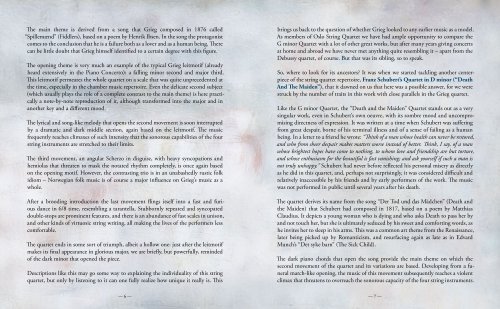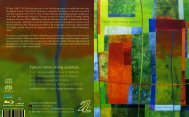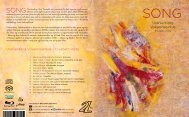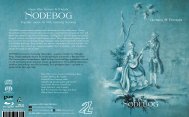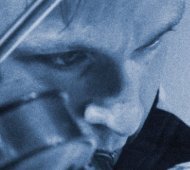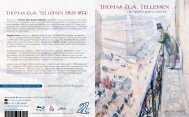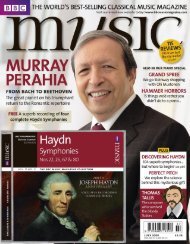Create successful ePaper yourself
Turn your PDF publications into a flip-book with our unique Google optimized e-Paper software.
<strong>The</strong> main theme is derived from a song that Grieg composed in 1876 called<br />
“Spillemænd” (Fiddlers), based on a poem by Henrik Ibsen. In the song the protagonist<br />
comes to the conclusion that he is a failure both as a lover and as a human being. <strong>The</strong>re<br />
can be little doubt that Grieg himself identified to a certain degree with this figure.<br />
<strong>The</strong> opening theme is very much an example of the typical Grieg leitmotif (already<br />
heard extensively in the Piano Concerto): a falling minor second and major third.<br />
This leitmotif permeates the whole quartet on a scale that was quite unprecedented at<br />
the time, especially in the chamber music repertoire. Even the delicate second subject<br />
(which usually plays the role of a complete contrast to the main theme) is here practically<br />
a note-by-note reproduction of it, although transformed into the major and in<br />
another key and a different mood.<br />
<strong>The</strong> lyrical and song-like melody that opens the second movement is soon interrupted<br />
by a dramatic and dark middle section, again based on the leitmotif. <strong>The</strong> music<br />
frequently reaches climaxes of such intensity that the sonorous capabilities of the four<br />
string instruments are stretched to their limits.<br />
<strong>The</strong> third movement, an angular Scherzo in disguise, with heavy syncopations and<br />
hemiolas that threaten to mask the notated rhythm completely, is once again based<br />
on the opening motif. However, the contrasting trio is in an unabashedly rustic folk<br />
idiom – Norwegian folk music is of course a major influence on Grieg’s music as a<br />
whole.<br />
After a brooding introduction the last movement flings itself into a fast and furious<br />
dance in 6/8 time, resembling a tarantella. Stubbornly repeated and syncopated<br />
double-stops are prominent features, and there is an abundance of fast scales in unison,<br />
and other kinds of virtuosic string writing, all making the lives of the performers less<br />
comfortable.<br />
<strong>The</strong> quartet ends in some sort of triumph, albeit a hollow one: just after the leitmotif<br />
makes its final appearance in glorious major, we are briefly, but powerfully, reminded<br />
of the dark minor that opened the piece.<br />
Descriptions like this may go some way to explaining the individuality of this string<br />
quartet, but only by listening to it can one fully realize how unique it really is. This<br />
brings us back to the question of whether Grieg looked to any earlier music as a model.<br />
As members of Oslo String Quartet we have had ample opportunity to compare the<br />
G minor Quartet with a lot of other great works, but after many years giving concerts<br />
at home and abroad we have never met anything quite resembling it – apart from the<br />
Debussy quartet, of course. But that was its sibling, so to speak.<br />
So, where to look for its ancestors? It was when we started tackling another centerpiece<br />
of the string quartet repertoire, Franz <strong>Schubert</strong>’s Quartet in D minor (“Death<br />
And <strong>The</strong> Maiden”), that it dawned on us that here was a possible answer, for we were<br />
struck by the number of traits in this work with close parallels in the Grieg quartet.<br />
Like the G minor Quartet, the “Death and the Maiden” Quartet stands out as a very<br />
singular work, even in <strong>Schubert</strong>’s own oeuvre, with its sombre mood and uncompromising<br />
directness of expression. It was written at a time when <strong>Schubert</strong> was suffering<br />
from great despair, borne of his terminal illness and of a sense of failing as a human<br />
being. In a letter to a friend he wrote: “Think of a man whose health can never be restored,<br />
and who from sheer despair makes matters worse instead of better. Think, I say, of a man<br />
whose brightest hopes have come to nothing, to whom love and friendship are but torture,<br />
and whose enthusiasm for the beautiful is fast vanishing; and ask yourself if such a man is<br />
not truly unhappy.” <strong>Schubert</strong> had never before reflected his personal misery as directly<br />
as he did in this quartet, and, perhaps not surprisingly, it was considered difficult and<br />
relatively inaccessible by his friends and by early performers of the work. <strong>The</strong> music<br />
was not performed in public until several years after his death.<br />
<strong>The</strong> quartet derives its name from the song “Der Tod und das Mädchen” (Death and<br />
the Maiden) that <strong>Schubert</strong> had composed in 1817, based on a poem by Matthias<br />
Claudius. It depicts a young woman who is dying and who asks Death to pass her by<br />
and not touch her, but she is ultimately seduced by his sweet and comforting words, as<br />
he invites her to sleep in his arms. This was a common art theme from the Renaissance,<br />
later being picked up by Romanticism, and resurfacing again as late as in Edvard<br />
Munch’s “Det syke barn” (<strong>The</strong> Sick Child).<br />
<strong>The</strong> dark piano chords that open the song provide the main theme on which the<br />
second movement of the quartet and its variations are based. Developing from a funeral<br />
march-like opening, the music of this movement subsequently reaches a violent<br />
climax that threatens to overreach the sonorous capacity of the four string instruments.<br />
— 6 — — 7 —


